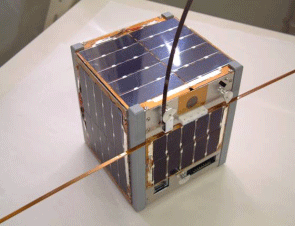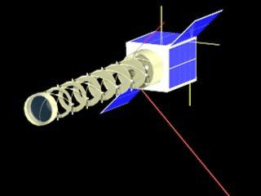 |
 |
|
|||||||||||||||||||||||||
|
| Development of Super-small Satellite Making Familiar to Space | ||
Shinichi Nakasuga, Prof., Department of Aeronautics and Astronautics, School of Engineering Speaking of space utilization, there may be a public's image; (1)big satellite,(2)requiring huge money, (3)long development time. The image may be deterring companies from entering. We desire to strip away such image, so that we would like to help people feel familiar to space. Our main study is the development of super small satellites, not heavier than 0.5 to 10kg. These satellites swell the possibility for space if they could play a role kept by large satellites, in the way they work in a formation by tens of pieces. We also engaged in "furoshiki satellite", meaning that the satellite party has a sheet unfold to generate solar power or collect debris. The small satellite is useful for deploying the membrane. We have launched a satellite "CubeSat" (1kg,10 cm³), the smallest of the world, respectively one in 2003 and the other in 2005. Usually it would cost more than 1 billion yen for a usual large satellite, while it cost just 2 million yen for each satellite's parts of our case. The both of them keep sending the vivid image of the earth taken by a tiny inside camera, which are distributed to more than 2000 people for free to please them. |
||
Launch is close together in line. One of the next models is "PRISM" (approximate 8 kg weight), equipped with a 30m-resolution camera, higher than that of "CubeSat".; another is "Nano-JASMINE" that is expected to measure stellar 3-D positions precisely in corroboration with National Astronomical Observatory.; one more is "PETSAT" whose mission is assemble panels with various functions. Japan is really a pioneer in this field and has been good at packing a variety of functions into a limited space, as is seen in traditional work of bonsai or hakoniwa. That may mean that super small satellite is the thing we can serve to the world. For the future, we desire to work for structuring a new aerospace system based on satellites loaded with artificial intelligence. Small satellite program is truly useful for education. Through the program, at least once, students could experience basic technology, manufacturing, launch testing, operation and so on. It would be a fantastic opportunity for realistic world is a better teacher than any other things. Doctor course students are to manage the program. I wish them to be good leaders as well as good researchers. |
||
I used to be crazy about airplane and enjoy copying drawings of fighters at my home. I found myself fascinated by the fact that the more I pursue the function the more beautiful the design turns. Eventually Apollo 11 brought me to my present work. I originally came from theory work like the application of artificial intelligence. I moved from a private company to University of Tokyo and I had a chance to visit Stanford University in 1999, when I was surprisingly impressed with the fact satellites could be produced in that dirty room. That experience charmed me, which led to my first work of 1999, the can-made model "CanSat". Idea wells up while sticking to idea. I like that. I come up with ideas, sometimes with integrated one while enjoying drinking, relaxing on sleeping, So I put a scratch pad under my pillow. My hobby is playing sports like tennis or baseball. I can recover myself from deadlock through exercises. My class enjoys a two-days camp every summer, doing only exercises with football or swimming. It seems like an athletic meeting. Here in COE, I'm keeping study work for obtaining spacious energy by the "Furoshiki Satellite". I think it a good stimulation to get associated with people from different fields. Ideas generated through such association may make me feel close to the universe. |
||
|
||
 <Personal Background>
<Personal Background>1988:Doctor of Eng. of Tokyo Univ. Employed at Japan IBM Tokyo Basic Research.1990: Lecturer and assistant prof. of Tokyo Univ. 2004:Prof . of Aeronautics and Astronautics. Engaged in design, production and management of ultra-small satellite, intelligence and autonomy for space system , research and education of innovative space system and navigation guidance control of space machines. Member of Aerospace Society of Japan, IAA, AIAA,SICE. IFAC Aerospace TC Japanese Branch Chairman, Related-Member of the Science Council of Japan. |
| <<Back | Page top |

